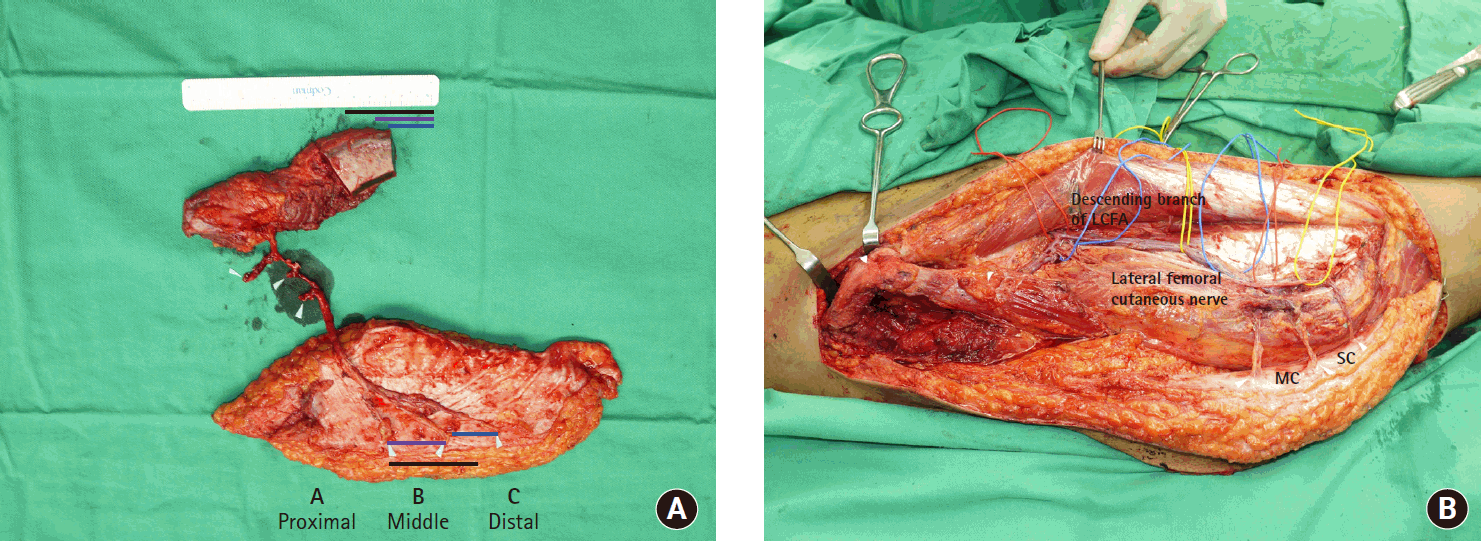1. Song YG, Chen GZ, Song YL. The free thigh flap: a new free flap concept based on the septocutaneous artery. Br J Plast Surg. 1984; 37:149–59.

2. Valdatta L, Tuinder S, Buoro M, Thione A, Faga A, Putz R. Lateral circumflex femoral arterial system and perforators of the anterolateral thigh flap: An anatomic study. Ann Plast Surg. 2002; 49:145–50.

3. Lee YC, Chen WC, Chou TM, Shieh SJ. Anatomical variability of the anterolateral thigh flap perforators: vascular anatomy and its clinical implications. Plast Reconstr Surg. 2015; 135:1097–107.
4. Lakhiani C, Lee MR, Saint-Cyr M. Vascular anatomy of the anterolateral thigh flap: a systematic review. Plast Reconstr Surg. 2012; 130:1254–68.
5. Mourougayan V. Variation in the vascular anatomy of anterolateral thigh flap and its management. Eur J Plast Surg. 2005; 28:340–2.

6. Kawai K, Imanishi N, Nakajima H, Aiso S, Kakibuchi M, Hosokawa K. Vascular anatomy of the anterolateral thigh flap. Plast Reconstr Surg. 2004; 114:1108–17.

7. Malhotra K, Lian TS, Chakradeo V. Vascular anatomy of anterolateral thigh flap. Laryngoscope. 2008; 118:589–92.

8. Seth R, Manz RM, Dahan IJ, et al. Comprehensive analysis of the anterolateral thigh flap vascular anatomy. Arch Facial Plast Surg. 2011; 13:347–54.

9. Darji AP, Chauhan H, Shrimankar P, et al. A cadaveric study of variations in the origin of lateral circumflex femoral artery. Int J Anat Res. 2015; 3:1732–6.

10. Tansatit T, Wanidchaphloi S, Sanguansit P. The anatomy of the lateral circumflex femoral artery in anterolateral thigh flap. J Med Assoc Thai. 2008; 91:1404–9.
11. Yu P. Characteristics of the anterolateral thigh flap in a Western population and its application in head and neck reconstruction. Head Neck. 2004; 26:759–69.

12. Yu P, Youssef A. Efficacy of the handheld doppler in preoperative identification of the cutaneous perforators in the anterolateral thigh flap. Plast Reconstr Surg. 2006; 118:928–35.

13. Xu Z, Zhao XP, Yan TL, et al. A 10-year retrospective study of free anterolateral thigh flap application in 872 head and neck tumour cases. Int J Oral Maxillofac Surg. 2015; 44:1088–94.

14. Lee JC, St-Hilaire H, Christy MR, Wise MW, Rodriguez ED. Anterolateral thigh flap for trauma reconstruction. Ann Plast Surg. 2010; 64:164–8.

15. Wolff KD, Kesting M, Thurmüller P, Böckmann R, Hölzle F. The anterolateral thigh as a universal donor site for soft tissue reconstruction in maxillofacial surgery. J Craniomaxillofac Surg. 2006; 34:323–31.

16. Nasajpour H, Steele MH. Anterolateral thigh free flap for “head-to-toe” reconstruction. Ann Plast Surg. 2011; 66:530–3.

17. Garvey PB, Selber JC, Madewell JE, Bidaut L, Feng L, Yu P. A prospective study of preoperative computed tomographic angiography for head and neck reconstruction with anterolateral thigh flaps. Plast Reconstr Surg. 2011; 127:1505–14.

18. Ao M, Uno K, Maeta M, Nakagawa F, Saito R, Nagase Y. De-epithelialised anterior (anterolateral and anteromedial) thigh flaps for dead space filling and contour correction in head and neck reconstruction. Br J Plast Surg. 1999; 52:261–7.

19. Ali RS, Bluebond-Langner R, Rodriguez ED, Cheng MH. The versatility of the anterolateral thigh flap. Plast Reconstr Surg. 2009; 124(6 Suppl):e395–407.

20. Bhadkamkar MA, Wolfswinkel EM, Hatef DA, et al. The ultra-thin, fascia-only anterolateral thigh flap. J Reconstr Microsurg. 2014; 30:599–606.

21. Liu WW, Yang AK, Ou YD. The harvesting and insetting of a chimeric anterolateral thigh flap to reconstruct through and through cheek defects. Int J Oral Maxillofac Surg. 2011; 40:1421–3.

22. Sananpanich K, Tu YK, Kraisarin J, Chalidapong P. Flow-through anterolateral thigh flap for simultaneous soft tissue and long vascular gap reconstruction in extremity injuries: Anatomical study and case report. Injury. 2008; 39 Suppl 4:47–54.

23. Demirkan F, Chen HC, Wei FC, et al. The versatile anterolateral thigh flap: A musculocutaneous flap in disguise in head and neck reconstruction. Br J Plast Surg. 2000; 53:30–6.






 PDF
PDF Citation
Citation Print
Print



 XML Download
XML Download